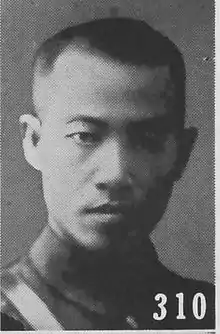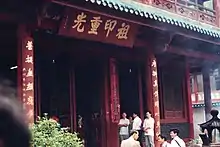Li Hanhun
Li Hanhun (traditional Chinese: 李漢魂; simplified Chinese: 李汉魂; pinyin: Lǐ Hànhún; 7 October 1895 – 30 June 1987), courtesy name Bohao (伯豪) and assumed name Nanhua (南華) was a Chinese (Kuomintang) general from Wuchuan, Guangdong. He participated in the Northern Expedition and Second Sino-Japanese War, in which he served with distinction.[1] A portrayal of his conduct as a frontline commander in 1938 can be found in chapter 3 of Freda Utley’s China at War.[2] For the later War years 1939-1945, he served as Chair (governor) of the Guangdong provincial government. His last role in public life was as Interior Minister during the acting-presidency of Li Zongren, the last Kuomintang administration in mainland China


Biography[3][4]
At age 17 Li joined the Tongmenghui (Revolutionary Alliance), the Society chiefly instrumental in the overthrow of the Manchu Dynasty and establishment of a Republican government in China in 1911. He became a career military officer on graduating from the Baoding Military Academy in the Academy’s sixth graduating class in 1919. He was a division commander in the famed “Iron” Fourth Corps of the National Revolutionary Army that helped eliminate the power of warlords and unify the nation in the late 1920s.
Li Hanhun played notable roles at several junctures in the conflict with Japan. As the Sino-Japanese War was brewing in 1936 and factions within the Kuomintang were in power struggles verging on civil war, Li gave up his commission with the leader of one faction (Chen Jitang 陈济棠), while issuing a universal call-out to all Chinese forces to unite under the leadership of Chiang Kai Shek in resistance against Japan invasion. In 1938, as commander of the 64th Army in the Battle of Lanfeng, he defeated General Kenjii Doihara in Luowangzhai (罗王砦), a depot town on the Longhai Railway where Doihara headquartered his main forces; Doihara had been the principal commander of Japanese forces in China and had been engaging in efforts to control China’s major railroad systems.
From 1939 to 1945, General Li served as Governor of war-torn and partially occupied Guangdong Province, during which he devoted himself to good governance and war relief efforts. As part of the latter efforts, he collaborated with and supported his wife Wu Chu-Fang (吴菊芳) in a range of enterprises to mitigate the problems of war-displaced refugees.
In 1947 after the War had ended, Li was granted permission for two years of medical leave to the United States, and a study tour to the Americas and Europe to observe post war reconstruction. Li returned to China in 1947, participated in the national election in which he was elected to the National Assembly, and also served as Minister of Interior during the brief acting-presidency of Li Zongren. When the Communists took over the mainland at the end of that year, General Li Hanhun emigrated to the United States to rejoin his family there.
Though his career in public life in China had mainly been in military service and War zone governance, General Li Hanhun was self-described as a reluctant warrior in his own writings and in his life-long devotion to Buddhism and Chinese classical learning. He was the principal facilitator in the 1934 restoration, under the abbot Xuyun, of the sixth century Nanhua Temple in Shaoguang, Guangdong; Li’s calligraphy on pillars and doorways of that Temple are still displayed today. His collected writings of essays, poetry, history, diaries and autobiography have now all been published.[5]
In 1949, Li Hanhun went with his family to the United States, where he lived in the New York City area for the remainder of his life. Together with his wife Wu Chu-Fang, they operated a series of three Chinese restaurants, the one in White Plains,[6] the China Garden, being particularly successful and famous in its time. The family history, against a backdrop of world events, is recounted in the book by his daughter Virginia Li: From One Root Many Flowers: A Century of Family Life in China and America.[7] In 1987, he died in New York. Former Harvard Professor Frederick Pei Li was his son.
References
- "Li Hanhun (李汉魂) appears as one among 229 cast-iron figures in the Square of Chinese Heroes in the Anti-Japanese War museum of the Jianchuan Museum in Chengdu China". you.ctrip.com. Retrieved 2018-11-10.
- Utley, Freda (1939). China at War (PDF). London: Faber & Faber.
- Li, Hanhun. Reminiscences of Han-hun Li : oral history, 1962.
- 枕上梦回: 李汉魂吴菊芳伉俪自传, 广东人民出版社, 2012-8-1 (Li Hanhun’s autobiography in Chinese).
- 李漢魂將軍文集, 中國社會出版社, 2015-1;
- "White Plains Restaurateur Gives Books to Columbia University". The Reporter Dispatch, White Plains, NY. April 24, 1968.
- Li, Virginia (2003). From One Root Many Flowers: A Century of Family Life in China and America. New York: Prometheus Books. ISBN 1591020816.